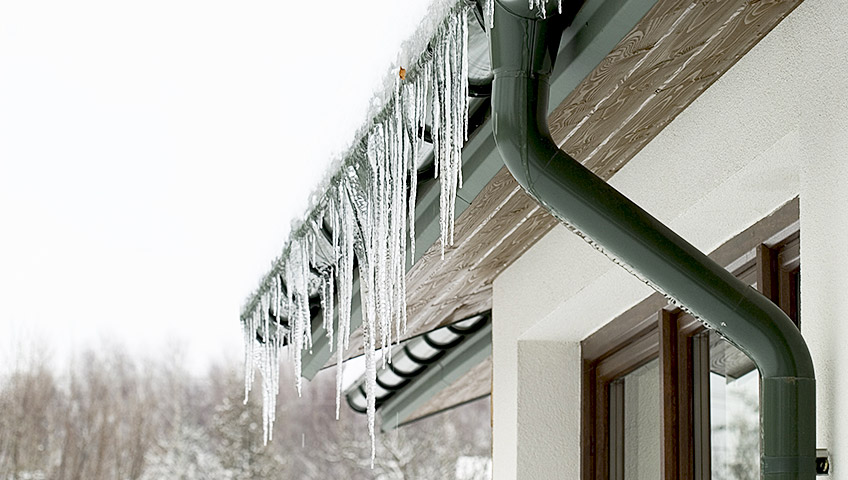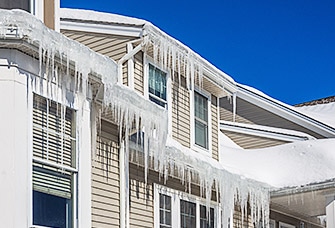
Preventing Ice Dams on Low-Sloped Roofs
November 10, 2020
A Complete Guide to Winter Gutter Maintenance and Ice Dam Prevention
When you have a winter season, its impact on your home will produce ice dams – it is a problem many have faced and corrected. The build-up of undrained water starts ice dams to creep from the gutters up the roof, but there is a solution to prevent this problem from multiplying. Installing water protection and gutter protection is the most important thing you can do to protect your roofing system’s good health. We want to share our solutions to maintain your system through the gutter systems available and how they will benefit you and your home. As part of our educational information, we will also share ways to keep your gutter clean before the winter freeze reducing problems in the long run. Gutters will leak from time to time and sag if they haven’t been adequately maintained, and there are ways to fix and avoid the problem that we will detail here. When a problem has gotten beyond the point of maintenance remediation, we can show you how to remove an ice dam without damaging your roof or gutters.
With the onset of the winter season comes the risk of ice damming and the problems it can cause your roof. Although many people are familiar with the term, they are unsure of how an ice dam is created, how it can damage their property, and how they can prevent them from forming.
What Causes Ice Dams?
Ice dams are formed by melted snow and are typically found around the drains and along the edges of your roof. These ridges or blocks of ice are created when the snow keeps melting and freezing continuously.
Ice dams are mostly formed when the temperatures keep fluctuating which causes heat loss through the roof. More specifically, the poorly insulated ceiling of the house and attic area. Due to poor roof ventilation, insulation, and air sealing in the higher portions, typically around the roof edges, the melted snow re-freezes, forming ice dams on the roof.
Types of Gutters
- Half-round gutters: installed at older homes, it consists of a half-round smooth surface. The gutters come in aluminum, copper or galvanized steel.
- K-style gutters: were named for the profile they produce. The way it lays out is that the gutter’s outer edge is a short line that follows the gutter’s bottom. Two opposite curves follow another straight line.
- Fascia-style, wide bottom gutters: they are more square and deeper than conventional gutters. They show a modern look and can disguise rafter tails if they are exposed.
Gutters Vary by Construction
Sectional gutters: strips of 10-20 feet of material that are assembled with seams along the strips. This system comes with corner pieces, end caps and drop outlets that connect downspouts.
Seamless gutters: long strips of aluminum, copper, steel or zinc. The sections have joints or mitre cuts at the corners and rolled out and affixed on a home with a machine.
Gutter manufacturers use several different materials to create their products, including:
- Vinyl/plastic gutters: made from PVC plastic, they rare virtually dent-free and resist corrosion. They cost less than conventional channels and are lightweight, making them easy to install.
- Aluminum gutters: are the best option for the installation of a seamless gutter. They move higher volumes of water; they are lightweight, have a long life and don’t rust.
- Steel gutters: will fit any budget constraint. They are strong and resist UV rays. Will handle high-volumes of water quickly, can be recycled, durability and flexibility built-in. Many different styles to choose from when you buy steel gutters.
- Copper gutters offer many features like durability, curb appeal, long lifespan, minimal maintenance, and complement copper roof or other features on the exterior of your home.
- Wood gutters: the material of choice here is cedar; it repels moisture for many years and extremely durable. Cedar stands up to the elements when other wood products would wilt from the onslaught of wintry weather. They look great and handle water well, making your home a conversation piece on your street.
Components of A Gutter System
- End caps: stop water from leaving the gutter system prematurely. They are flat pieces of material shaped and attached to a section of the gutter attached to the side of the home.
- Gutter hangers: installed inside the gutter, they act as a brace for the gutter when attached to the home.
- Downspout: is a vertical channel installed on the side of the home that channels water down the side of the house and away from it.
- Downspout bracket: they attach the downspout to the side of the home to provide a secure connection to the pipe to drain water.
- Elbow/boot: the elbow is located at the bottom of the downspout and works to move water away from the home. The boot is a metal section that guides water to an underground pipe and is used in high-traffic areas beyond the downspout.
- Downspout extension: controls water flow and is an add-on to the downspout. It directs water to predetermined areas for drainage.
- Gutter downspout diverter: it diverts rainwater to your rain barrel for collection and helps with gutter drainage.
- Gutter guards: is a filter system that prevents debris from accumulating in your rain gutters. Contact Integrity Roofers for more information on the benefits of gutter guards.
The Cause of Build-Up in Gutters
Gutters that move water slowly or are clogged impede water from flowing. This is a problem in the winter because standing water will freeze faster than moving water. Ever see a river in the winter? The water continually moves to stop freezing from occurring. Your rain gutter works on the same principle: moving water doesn’t freeze. When left to stand or move slowly, water will freeze on the spot, forming ice dams. Clogs are the nemesis of a rain gutter; once the water stops moving, ice will form, presenting a problem for a homeowner.
Gutter Damage from Snow And Ice
When water freezes, it expands and becomes heavier. It will force sections of the gutter away from the home, cause cracks and create more damage. When the gutter is under more weight than it was designed to support, you will see sagging because the brackets won’t support the gutters with too much weight attached to them. When sagging occurs, it will cause alignment problems, and the course of water flow will change. Seeing ice gams hanging over gutters affects property values and are unsightly when presented.
How To Inspect Gutters For Structural Damage
- Look for sagging – this is will be evident on a visual inspection
- Look for dents – it will tell you if ice has been pushing against the inner channel of the gutter
- Measure gutter angle or slope – this will say to you if extra weight has been placed on the gutter
- Request an inspection from Integrity Roofers
What are the Risks of Ice Damming?
When the snow melts and becomes water, it can reach the soffit and refreeze, causing ice dams on your roof resulting in the following roofing problems:
- Water leaks in the attic
- Damage to the interior walls
- Water-stained ceilings
- Curved or cracked shingles
- Damaged insulation
- Sagging gutters
Preventing Ice Dams on Roofs
If you wish to get rid of ice dams on your roof, you must adhere to the following:
-
Remove Snow from the Roof
When you notice snow building up on your roof, it is advised to have it removed because this prevents ice dams from forming. Call for the assistance of professional roofers to get the job done safely.
-
Attic Insulation
This is one of the primary measures to help you prevent ice dams. Insulation helps to prevent heat loss and does not allow snow to melt and re-freeze due to fluctuations in temperature.
-
Roof Ventilation
In addition to attic insulation, proper roof ventilation will ensure that your attic and roof are functioning as required. It will allow you to control the heat by keeping a uniform temperature throughout your home, allowing heat to escape through the vents installed.
-
Examine Eavestroughs
If you have questions about how to get rid of ice dams in gutters and eavestroughs, a roof inspection is an ideal solution. When you get your roof inspected, make sure to check whether the eaves are sloped adequately so that the water gets drained when the snow melts.
-
Roof Inspection
It is one of the most reliable ways to prevent ice dams on your roof. Proper roof inspections will allow you to detect any problems with the components of your roof, giving you an opportunity to replace the damaged or worn out parts.
How To Keep Water Flowing Through The Gutters In Winter
- Clean gutters – remove all debris no matter how small; even the tiniest leaf will be the start of a massive backup.
- Realign the gutters – gutters must be slightly sloped to move water with the force of gravity. If the alignment is out by even less than an inch, water won’t move to the destination it was intended to end at
- Leaf gutter protection systems eliminate a great deal of the build-up in the rain gutter and have become a must-have at any home. Check-in with us at Integrity Roofers to discuss the protection systems we have available
FAQs
Q: Do gutters cause ice dams?
A: No, but they aid and abet ice dams when they form. Water will concentrate in gutters and cause problems in vulnerable areas of the roofing system.
Q: Will removing gutters prevent ice dams?
A: No, ice dams are formed due to heat leakage from your attic to the roof. Water transfers to the gutter, and when standing, it will freeze. You will have ice dams if your attic insulation is weak or non-existent.
Q: When do you clean gutters, and how often?
A: Twice a year, usually in the fall and late spring.
Q: Why clean gutters before winter and before spring?
A: Autumn leaves will cause clogs in gutters and stop water from flowing. As we mentioned, standing water is the curse of gutters in the winter. In the early spring, cleaning gutters prepare the gutters for all the rainwater they will see in the spring and summer.
Q: How do you keep gutters from freezing?
A: Keep the gutters clean and free from impediments. You can salt your gutters, check your gutters’ slope, check your attic insulation, shovel off your roof, and engage in roof maintenance.
Q: Do gutter guards prevent ice dams?
A: No, they don’t prevent ice dams or icicles from forming, but they do prevent debris that slows water flow that creates the ice in the gutters.
Q: Should you remove gutter guards in the winter?
A: If the gutter guards are the only cause of the ice dams, the answer should be yes. But, as we know, many things cause ice dams, and you need to solve the problems that cause ice dams before removing the gutter guards.
Contact the Professionals at Integrity Roofers to Prevent Ice Damming in Toronto

For more details about our winter roofing services, you may get in touch with our specialists by calling 416-736-7373. You can also contact us online to get a professional estimate.



















